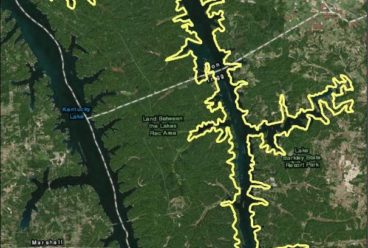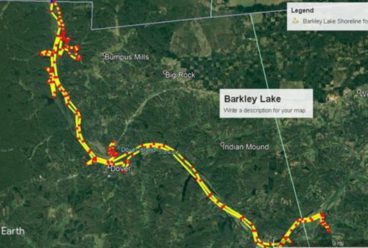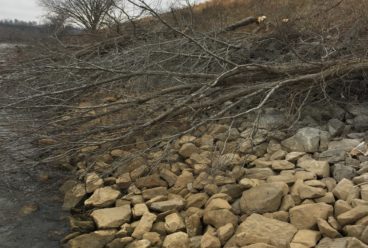Overview
-
Status
Complete -
Completion
2022 -
Location
Lake Barkley, Kentucky -
Grants Received
$31,541 -
Total Budget
$101,684 -
Friends Group
Kentucky B.A.S.S. Nation -
Partners
U.S. Army Corps of Engineers, Kentucky Department of Fish and Wildlife Resources, Kentucky B.A.S.S. High School Trail West, Tennessee Wildlife Resources Agency, U.S. Forest Service, Wired2Fish, Murray State University Bass Anglers, McCracken County High School Bass Team
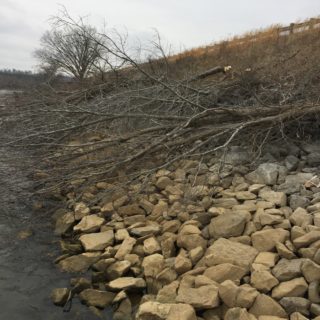
Goals of the Lake Barkley Habitat Improvement Project are as follows: 1) To decrease siltation and the expansion of mud flats by increasing shoreline stability through cypress tree plantings, 2) to mitigate the effects of existing siltation and increase centrarchid spawning success by: (a) improving available shoreline spawning cover by placing laydowns and (b) increasing available spawning substrate by adding artificial spawning beds, 3) to increase the abundance of sportfish and improve angler satisfaction rates in Lake Barkley through the addition of artificial spawning habitat and fish attractors, 4) to limit the negative effects of the current water regime and climate change by placing suitable fish habitat in areas less prone to dewatering, excessive turbidity, and wave action, 5) to use volunteer efforts and social media to promote the connection between aquatic habitat and fish populations, 6) to refine the science surrounding the influence of habitat on centrarchid recruitment.
Why It Matters
Lake Barkley is a mainstem impoundment created in 1966 and is the last and largest reservoir in the Cumberland River system. It is managed by the U.S. Army Corps of Engineers (USACE) for flood control, navigation, power generation, and recreation. The fisheries are managed jointly by the Kentucky Department of Fish and Wildlife Resources (KDFWR; 45,600 acres) and the Tennessee Wildlife Resources Agency (TWRA; 12,000 acres). The Land Between the Lakes National Recreation Area makes up the majority of the western shoreline and provides a relatively undeveloped shoreline. A few miles upstream from Barkley Dam, a canal joins it to Kentucky Lake. During a typical year, the USACE begins gradually raising water levels to a summer pool elevation of 359 ft above sea level on April 1. Lake elevation is held at summer pool until July 5th when the elevation is gradually lowered to a winter pool elevation of 354 ft above sea level.
According to creel surveys in both states, anglers make an average of over 300,000 fishing trips to Lake Barkley annually. Black bass and crappie are the most sought after sport fish species making up an average of 40% and 25% of the fishing trips, respectively. The tourism industry surrounding Lake Barkley and the adjoining Kentucky Lake generates a combined $1.3 billion in annual estimated economic activity.
Threats
As the reservoir has aged it has lost most of its original flooded terrestrial cover. Large expanses of open water, heavy recreational boating activity, and the current water regime have resulted in a shoreline prone to erosion and largely devoid of vegetation.
For much of the lake’s history, the drawdown to winter pool began on June 15th and the initial drawdown was quite rapid which allowed for the proliferation of button bushes out to an elevation of 357 ft above sea level. However, in 1980 the summer pool duration was extended by delaying the start of the winter drawdown to July 5th. Although unintended, this extension of 20 more days of summer pool likely resulted in the eventual mortality of the deeper button bushes. Current stands of button bush are limited to a depth of ~358 ft above sea level. Because summer pool elevation is 359 feet above sea level, this leaves only 1 foot of water depth with useful woody cover during normal reservoir operations. Furthermore, submerged aquatic vegetation has been very uncommon in the reservoir’s history due to a combination of the water regime and the high levels of turbidity which prevent suitable light penetration in most years. In the backs of embayments, the siltation and current water regime have created vast mudflats that provide few biological benefits for most species.
Climate change may be making these issues worse. Recent analysis of long term temperature data from neighboring Kentucky Lake shows a trend of increasing water temperature since data collection began in 1988 (Dr. Susan Hendricks, personal communication). Because temperature affects the timing of largemouth bass spawns, increasing water temperatures in the spring may result in fish attempting to spawn before suitable shallow cover is flooded as the reservoir fills. Higher frequencies of major flood events may also be negatively affecting the abundance of our sportfish. Most notably, weak spawns by largemouth bass in Lake Barkley have been observed in years with heavy rainfall, while good spawns are observed in years with low rainfall. Although the exact mechanisms are unknown, it is certain that years with higher rainfall exhibit larger fluctuations in water elevation. Larger water level fluctuations may cause shallow spawning bass to abandon nests at higher rates. Because the current predominant source of shallow cover (button bushes) is limited to such shallow depths, even small fluctuations in water levels and temperatures may have strong negative effects.
Many sportfish species (bass, crappie, sunfish) require certain spawning conditions to have a successful spawn. In addition to their own optimal spawning water temperature, each species also needs a certain amount of cover. Bass, crappie, and sunfish all generally create small depressions, known as beds, to spawn in. Frequently these beds are located on gravel substrate. In addition to areas with gravel substrate, beds are often found immediately adjacent to some form of woody cover like a natural laydown in the water or a stump if available. Hunt et al. (2002) determined that male black bass typically create beds near simple cover and about 30 feet apart from one another. Some areas in Lake Barkley still provide these conditions for a good spawn, but in many cases gravel has been silted over and woody cover that was once present in now gone. This leaves vast areas of the lake as open mudflats that provide little utility for spawning.
In recent years, many bass anglers have noticed a decline in their catch rates. KDFWR and TWRA have seen a similar trend of reduced largemouth bass recruitment in their electrofishing surveys. Catch rates of bass in all size classes have declined over the last 20 years, especially in the last decade. The number of bass (and all sportfish) in the population ultimately depend on spawning conditions and the ability of young of year fish to recruit into the population. Recently, lake conditions during the spawning period in the spring have been unpredictable and only sporadically conducive to good bass spawns. For example, water level fluctuations during the spawn can leave a nesting male bass in such shallow water that he abandons the nest or his nest may become completely exposed. Furthermore, rapid water temperature increases during the spring spawn seem to be occurring more often in Lake Barkley than in the past, leaving several species attempting to spawn simultaneously instead of the natural progression of spawning periods that we might see during a more gradual spring warm up. These effects along with a severe lack of appropriate spawning habitat have likely lead to several weak spawns, resulting in fewer bass in the population in Lake Barkley.
What FOR Accomplished
Report
A habitat improvement project was recently completed at Lake Barkley. Target species for habitat improvement were Largemouth Bass, Smallmouth Bass, Crappie spp., and Sunfish spp. The 57,000 acre mainstem impoundment is over 50 years old and has lost some natural habitat due to age, siltation, and water level fluctuations. Work was completed in the Kentucky and Tennessee portions of the reservoir and included multiple state, federal, and private partners. In the Kentucky portion, the Kentucky Department of Fish and Wildlife Resources initiated the project with fish attractors in the form of shallow water stake beds, and deepwater brushpiles. In addition to the fish attracting structures, the primary focus was improving the littoral zone habitat in ways specifically designed to increase the spawning success of the black bass, crappie, and sunfish in the reservoir. This work included adding shallow water hardwood laydowns, and concrete artificial spawning beds. The efficacy of these spawning structures was evaluated by conducting snorkel surveys, electrofishing, and hatch date analyses. Bald cypress trees were also planted to decrease erosion and provide spawning habitat in the future. The Tennessee Wildlife Resources Agency was offered and accepted a partnership with this grant that included installation of 8 deep water fish attractors, 320 artificial shallow water fish attractors, and 140 artificial spawning structures. The success of this project will be monitored by conducting electrofishing surveys annually in the spring and fall so that population characteristics may be compared to historic levels.
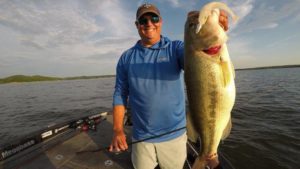
Proposed Project
This project plans to address several impairments of the Southern Appalachians Region as indicated by the RFHP including: siltation, mudflats, limited littoral structure, and water regime. The overall project will be split into six main habitat type categories: cypress tree (Taxodium distichum) planting, shallow water laydown placement, addition of artificial spawning beds, refurbishing shallow stakebeds, refurbishing deepwater fish attractors, and placing artificial shallow water fish attractors.
Cypress Tree Planting
Cypress trees are native to western Kentucky and are one of only a few species that can thrive along the shoreline and within the drawdown zone of Lake Barkley. These trees are known to have complex root systems that can help prevent bank ero-sion. If awarded this grant money, 1000 young cypress trees (averaging 5 ft tall) will be procured from Hillis Nursery in McMinnville, TN. KDFWR has planted young cypress trees in the past and found that trees that have grown out for at least an additional year have much higher survival rates than shorter seedlings. Trees will then be planted, typi-cally in groves of several individual trees, along the shoreline of Lake Barkley. Sites for plantings will be chosen by KDFWR and will focus on mudflat areas and areas with highly eroded banks.
Previous cypress tree plantings by KDFWR and USACE have shown that trees planted in the drawdown zone at an elevation of 357 ft above sea level or higher have a greater chance at survival. While the underground portions of cypress tree root systems help to stabilize banks and reduce the rate of mudflat formation, the exposed portion of the roots (the knees) can act as shallow water fish habitat once a large size is reached. The shade of the larger trees can also provide some thermal refuge for aquatic and terrestrial organisms. In addition, cypress trees will require nutrients to survive and grow. It is possible that this process could reduce the input nutrient runoff into the system as cypress trees capture nutrients near the shoreline. In these ways, cypress trees are especially useful in such a large reservoir.
Shallow Water Laydown Placement
Much of the littoral woody fish cover that once existed in Lake Barkley is no longer present, leaving huge expanses of shoreline with little cover in some places. This is true of most shoreline areas, including mudflats. This project aims to replace a portion of this cover to improve the spawning success of bass. Crappie and sunfish species also commonly use laydowns as spawning habitat, but we chose to focus them towards bass because bass are the most sought after species by anglers in Lake Barkley and recent bass spawns have been poor.
1200 trees less than 6” diameter at breast height will be cut from the shoreline of Lake Barkley. Cut trees will then be attached to two concrete blocks and placed on the lake bottom at elevations between 350 and 357 feet above sea level. Creating available woody cover at elevations deeper than the existing button bushes should mitigate against the effects of minor (+/- 1 foot) water level fluctuations. In order to en-courage the usage of this spawning cover by largemouth bass, each laydown will be spaced approximately 30’ apart. This spacing is necessary to avoid overlapping nesting territories of male bass. Because suitable bottom substrate may also be an important component of bass nest site selection, the majority of these laydowns will be placed in areas with fine or course gravel. In areas with excessive siltation, laydowns will be accompanied by an artificial spawning bed. Even if not used for spawning activities, laydowns should provide an immediate form of shallow habitat for many species.
Hardwood trees do not last forever and will not provide permanent fish habitat. However, due to their shallow locations, their longevity can be monitored and deteriorated trees can be replaced utilizing the same concrete blocks.
Artificial Spawning Beds
Due to reservoir aging, siltation, and the current water regime, much of the littoral zone no longer has suitable substrate for spawning centrarchids. Although abundant gravel exists on the shoreline above summer pool elevation, the gravel below summer pool elevation is often covered in several inches, and in some cases several feet, of silty sediment. To increase the availability of suitable gravel in the littoral zone, 450 artificial spawning beds made of concrete and filled with locally obtained gravel will be created.
To encourage usage by largemouth bass and other centrarchids, each artificial bed will be approximately 24 inches in diameter and 8 inches deep on the interior. Each bed will be created on shore using concrete poured into cylindrical plastic molds and hand finished to create a steep sided bowl shape. Loose gravel collected in situ will be loosely pressed into the centers of the bowl shapes to allow hiding spaces and simulate a natural substrate for fry. An additional 3-4 inches of loose gravel will then be added to better mimic natural substrate. After sufficient curing, the molds will be removed and the beds will be carried down the bank to a suit-able water depth. Artificial spawning beds will be spaced approximately 30’ apart, and near a shallow water laydown or artificial shallow water fish attractor site at elevations between 357 and 353 feet above mean sea level. Due to their steep sided morphology and durable concrete construction, we are hopeful that these artificial spawning beds will resist siltation and remain useful for our sportfish for many years.
To the best of our knowledge, this approach has not been attempted in a reservoir the size of Lake Barkley. Whether we succeed or fail at improving recruitment, we will publicize our methods and results to inform other reservoir managers.
Shallow Water Stakebeds
KDFWR refurbishes stakebed style fish attractors in Lake Barkley every other year. Fish attractors are structures meant to concentrate fish in one area to assist anglers in their pursuit of a catch. Fish attractors work because they provide cover for smaller individuals as well as ambush points for more piscivorous species. In many areas, fish attractors placed by KDFWR, TWRA, or a different organization are the only source of habitat for fish. Stakebeds consist of several dozen wooden stakes (each approximately 1” x 1” and 7 ft tall) that are placed closely together in shallow water (typically <8ft at summer pool). Stakebeds are often the only source of shallow water cover on mudflats that is not directly along the shoreline. Stakebeds commonly hold sportfish such as crappie, sunfish species, and the occasional bass. In the most recent survey, 55% of anglers responded that they at least occasionally utilize KDFWR fish attractors.
There are currently 206 stakebeds in Lake Barkley that will be refurbished in the summer of 2021. Stakebeds are located in embayments along both sides of the main river channel. Stakes are pushed into the substrate by hand. Over time wood stakes deteriorate, so they are refurbished every two years, while new stakebeds are added as mate-rials are available. In 2021, KDFWR will purchase ten bundles of stakes to refurbish all Lake Barkley stakebeds. All stakebeds will be marked with a long section of white pvc pipe. The USACE requires all shallow water habitat that is not directly along the shoreline to be marked for safety reasons. Coordinates of all stakebeds are available for anglers to download on the KDFWR website.
Deepwater Fish Attractors
In addition to stakebeds, KDFWR will be refurbishing deep water fish attractor sites during the winter of 2021-2022. Deepwater fish attractors provide additional cover for fish species that may be less likely to be found in shallow water at certain times of the year. There are 32 deepwater sites that will be refurbished in 2021-2022. For each deepwater site, three trees will be sunk using concrete blocks. Rope will be used to secure concrete blocks to trees. Coordinates of all deepwater sites are available for anglers to download on the KDFWR website. Fish attractor buoys will be placed at 15 deepwater sites by the USACE. Fish attractor buoys make it easier for anglers without GPS to utilize the resource.
TWRA will also be creating 16 plastic/concrete deepwater fish attractors in the Tennessee portion of the project site. Coordinates to those sites will also be available to the public.
Artificial Shallow Water Attractor
In the Tennessee portion of the reservoir, due to aging and lack of natural structure available, additional structures will be constructed using a 5 gallon bucket, an 80 lb. bag of concrete, and approximately 60’ of ¾” gas pipe per shallow water attractor. These shallow water attractors will be constructed by mixing a bag of concrete in a mixer and pouring it in a 5 gallon bucket. Before the concrete hardens 15 to 20 sections of ¾” gas pipe will be installed in the bucket creating a webbing radius of approximately 6’ of structure for fish to utilize. The shallow water attractors will be installed into select embayments with 4 individual attractors per site and 10 sites per embayment. An artificial spawning bed will be placed in close proximity to each attractor site. Embayments targeted for these installations include Yellow, Guices, Lick, Dyer, Hickman, and Saline Creeks, as well as Neville Bay and Gatlin Point embayments. Sites were selected to correspond with standard sportfish collections in the spring and fall of every year. This design should allow a pre and post-treatment evaluation of the effects of the new fish attractors.
Outreach Plan
Partners of this project are in the field and on the lake everyday talking with constituents of Lake Barkley. In addition to these daily interactions, the Kentucky Department of Fish and Wildlife Resources will distribute a press release to regional and local media outlets highlighting the project and its partners if funding is awarded. Several partners, including the USACE, KDFWR, TWRA, and the Kentucky B.A.S.S Nation, have social media pages where updates and information will be posted. KDFWR will provide video and photo updates on the Western Kentucky Fisheries Facebook page detailing this work as it progresses. Social media postings from our partner Wired2Fish will also focus on the science of reservoir fish habitat management and the importance of the connection between fish habitat and angler catch rates. Given the reach of our partners, we anticipate that a minimum of 500,000 people will be reached by these social media postings.
We expect volunteers to help move this project along. Many volunteers will likely be associated with the Kentucky B.A.S.S Nation and their member groups, such as the McCracken County High School Bass Fishing Club. Other partners include the Murray State University Bass Anglers, U.S. Forest Service and Kentucky Bassmasters. Wired2Fish is a local business with a large nationwide social media following that has agreed to provide an article detailing our habitat efforts on Lake Barkley. We would like to include active anglers and anyone who may be interested in learning about fisheries throughout the process of this work so they can learn through hands-on experience. In our experience, the best outreach efforts are often ones driven by members of the public rather than government agencies. TWRA will seek additional volunteers through an ongoing partnership with the University of Tennessee at Martin – Wildlife Society Chapter, as well as seeking additional cooperation from Tennessee B.A.S.S. Nation members.
Related News
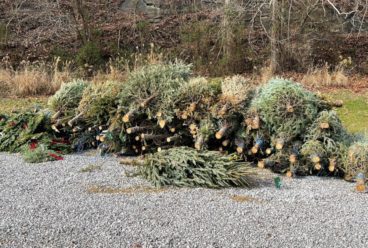
Kentucky Fish and Wildlife recycling donated Christmas trees
Kentucky Fish and Wildlife has set up several locations around the region to drop off live, undecorated Christmas trees. Fisheries biologists can use the live trees to create and enhance […]
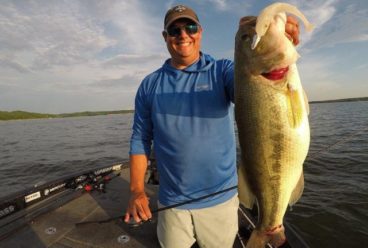
Largemouth Bass Populations: What Affects Bass Fishing on Large Reservoirs
“TVA biologists monitor the levels of vegetation in their reservoirs,” Martin said. “They does flyovers every year, and we have a lot of data on surface acres of grass on […]
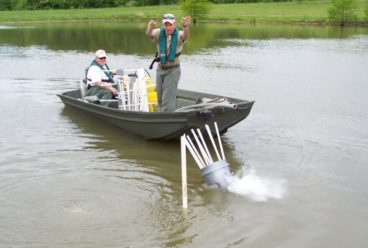
Big lakes’ public fish attractors offer anglers an edge
Where to fish is always a looming question, but on many Kentucky waters, including the vast area fisheries of Kentucky Lake and Lake Barkley, there are some shortcuts available. At […]
Donate Today
to support similar habitat projects


